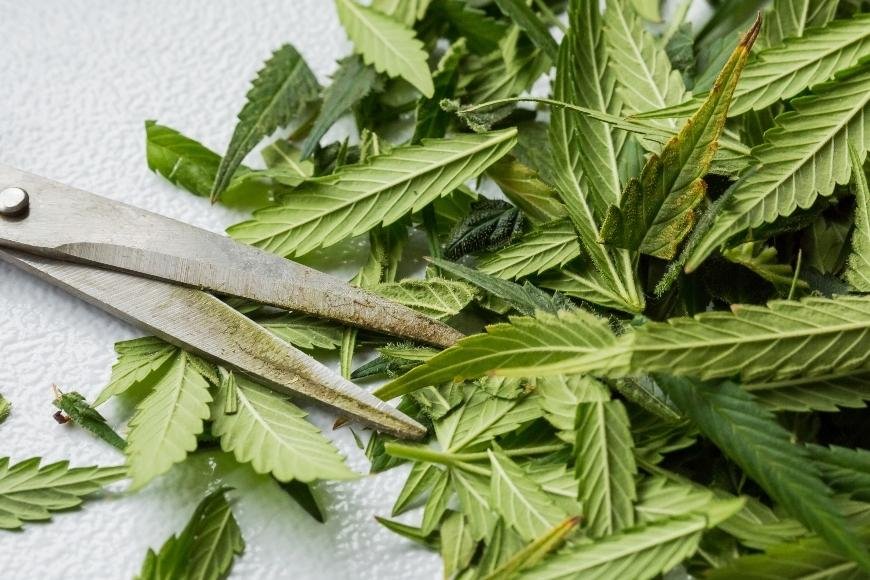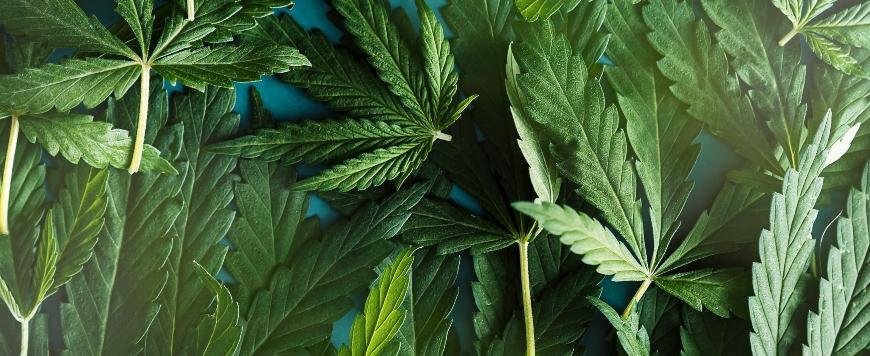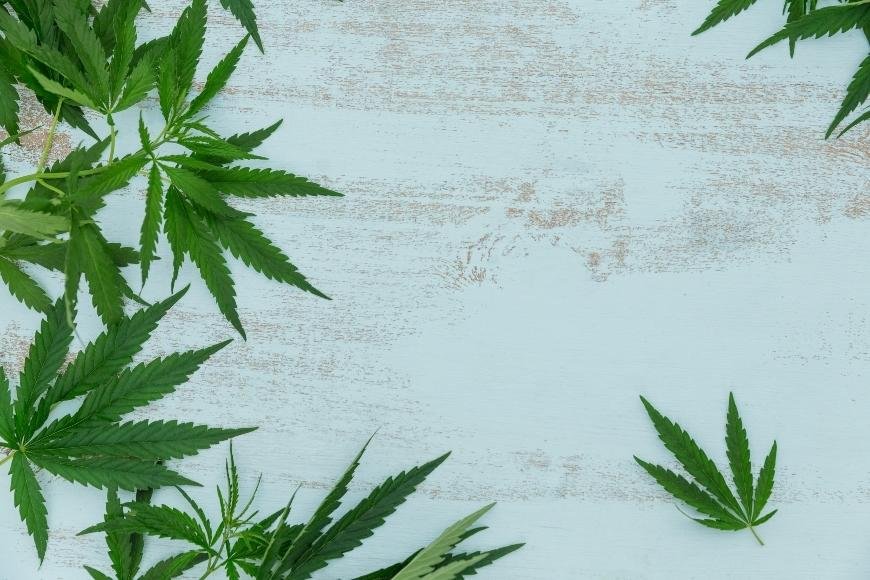Defoliating Cannabis Plants: How To
Learn Defoliating Cannabis Plants: How To boost growth and yields with our guide on defoliation techniques, timing, and tools for healthier plants.

Defoliating cannabis plants: how to master this technique for optimal growth and yield? As a vital aspect of cannabis cultivation, defoliation can significantly impact the overall health and productivity of your plants. In this comprehensive guide, we will delve into the intricacies of defoliating cannabis plants, ensuring you have all the knowledge necessary to make informed decisions about your own growing endeavors.
We'll start by discussing what defoliation is, its benefits, and different types available. Next, we'll explore when it's best to defoliate cannabis plants based on factors such as plant age and stage in their life cycle. After covering the fundamentals, we will then provide a detailed walkthrough of how to properly and efficiently remove leaves from your plants.
Furthermore, our guide will cover essential aftercare practices for maintaining healthy growth post-defoliation while also highlighting common mistakes made during the process. By understanding these potential pitfalls beforehand, you can avoid them altogether - leading to more successful outcomes in cultivating robust and thriving cannabis plants.
Table of Contents:
- The Benefits of Defoliating Cannabis Plants
- When to Perform Defoliation on Your Cannabis Plants
- Tools and Techniques for Effective Defoliation
- Identifying Fan Leaves and Bud Sites
- Monitoring Growth and Avoiding Over-Defoliation
- Topping vs Defoliating Cannabis Plants
- Frequently Asked Questions Defoliating Cannabis Plants: How to
- Conclusion
The Benefits of Defoliating Cannabis Plants
Defoliation is a technique that involves selectively removing leaves from cannabis plants to improve air circulation, increase light penetration, and boost yield. By enhancing airflow around the plants, defoliation reduces temperature and humidity issues while minimizing the risk of pests or mold infestations.
Cannabis plants require a great deal of sunlight (or artificial lighting) to generate energy through photosynthesis. Large fan leaves often block valuable light from reaching lower bud sites on the plant, leading to reduced yields as those buds receive less energy than they need to grow properly. Through proper defoliation techniques like lollipopping, you can ensure that more light reaches all parts of your plant's canopy - ultimately resulting in bigger harvests with denser buds.
- Better air circulation: Improved airflow helps maintain optimal temperatures and humidity levels within your grow space while reducing the likelihood of mold or pest problems.
- Increase in available light: Removing select fan leaves allows more sunlight (or artificial lighting) access throughout your plant's canopy, resulting in better energy distribution and increased bud growth.
- Higher yields: With improved air circulation and light penetration, your cannabis plants will be able to produce more buds - leading to higher overall yields at harvest time.
In addition to these benefits, defoliating cannabis plants can also help you identify any potential issues with your plant's health early on. By regularly examining the leaves during defoliation, you can gain insight into your plant's health and detect any nutrient deficiencies or other issues that may arise.
Defoliation is a great way to maximize the potential of your cannabis plants and can be an effective tool for increasing yields. Knowing when to execute defoliation in various growth stages is critical for achieving optimal outcomes.

When to Perform Defoliation on Your Cannabis Plants
Timing is crucial when it comes to defoliating your cannabis plants. It can be performed once during their vegetative stage (when they need maximum light) and once during their flowering stage (to promote healthy growth). Avoid defoliating autoflowering weed plants as much as possible since they rely heavily on their leaves for essential functions.
Vegetative Stage Defoliation
In the vegetative stage, cannabis plants focus on growing stems, branches, and foliage rather than producing buds. This is an ideal time to perform defoliation because it allows you to maximize light penetration while minimizing stress on the plant. Generally, you should start removing fan leaves around 4-6 weeks into the vegetative phase or when your plant has developed at least five nodes with branching structures.
- Tip: Only remove about 20% of the large leaves at a time in order not to shock your plant too much.
- Note: If you're growing indoors under artificial lighting, make sure that all parts of your cannabis plant receive adequate illumination after defoliating by adjusting lights accordingly.
Flowering Stage Defoliation
The second opportunity for defoliating occurs during the early stages of the flowering phase. At this point, bud sites are starting to form along with resinous trichomes that produce cannabinoids like THC and CBD. By carefully removing some larger fan leaves blocking these bud sites from receiving optimal sunlight or artificial light, you can increase the overall yield and potency of your cannabis plants.
- Tip: Perform flowering stage defoliation within the first 2-3 weeks after switching to a 12/12 light cycle for photoperiod strains or when buds begin forming on autoflowering varieties.
- Note: Be cautious not to remove too many leaves at once during this stage, as it could stunt growth and reduce overall yields. Aim for no more than 20% leaf removal per session.
In both stages, remember that moderation is key. Over-defoliating can cause undue stress on your cannabis plant's delicate systems, especially in autoflowering varieties sensitive due to their reliance upon leafy energy stores. Monitor your plant's growth after defoliation and adjust the frequency of interventions based on individual circumstances and preferences.
Thus, defoliation should be executed in both the vegetative and flowering stages for optimal results. To ensure successful results, it's essential to use the right tools and techniques for effective defoliation such as mastering the Slide'N'Snip technique.
Tools and Techniques for Effective Defoliation
To perform defoliation effectively without causing stress to your cannabis plant, it's essential to use the right tools and master specific techniques. In this section, we'll discuss how to choose suitable equipment and learn a popular method called Slide'N'Snip.
Choosing the Right Tools
The first step in successful defoliating cannabis plants is selecting proper cutting instruments. Using dull or inappropriate tools can cause damage to your plant, leading to slower recovery times after pruning. Here are some recommended options:
- Sharp scissors: A pair of sharp scissors designed specifically for trimming plants will ensure clean cuts that minimize stress on your cannabis.
- Garden shears: These specialized cutting devices are perfect for removing larger leaves or branches with ease while reducing strain on your hands during extended pruning sessions.
- Tweezers: For more delicate work around bud sites, tweezers can help you remove small leaves without damaging nearby flowers or stems.
Mastering the Slide'N'Snip Technique
The Slide'N'Snip technique optimizes light distribution at the top of the plant while maximizing airflow around its foliage by pinching off fan leaves with your non-dominant hand before cutting them away in stages using sharp scissors. Follow these steps to execute this method correctly:
- Select a large fan leaf blocking light penetration or air circulation near bud sites.
- Grasp the leaf stem's base with one hand (not your dominant one) and, slowly moving down it, snip off at its connection point to the main branch or stalk using sharp scissors held in your other hand.
- Carefully slide down along with the stem until you reach where it connects to the main branch or stalk.
- With your other hand, use sharp scissors to make a clean cut at the connection point, removing the leaf from the plant.
By practicing this technique regularly during cannabis defoliation sessions, you'll ensure that your plants receive optimal light penetration and airflow while minimizing stress on their delicate structures. Remember always to sterilize your tools before and after each session to prevent potential infections or pest infestations in your garden.
Identifying Fan Leaves and Bud Sites
Fan leaves are large leaf structures vital for photosynthesis but may block valuable sunlight from reaching lower parts of your cannabis plant if left unchecked. As you trim these fan-like appendages back progressively over time, remember that timing matters; too early or late can harm your marijuana crop instead of helping it flourish.
Importance of Fan Leaves in Photosynthesis
Fan leaves play a crucial role in the photosynthesis process, which is how plants convert light energy into chemical energy to fuel their growth. Chlorophyll, the light-capturing pigment present in fan leaves, is essential for photosynthesis to occur. By defoliating cannabis plants selectively, you can ensure that enough fan leaves remain on the plant to support its growth while still allowing more light penetration to reach other areas.
Recognizing Bud Sites
Bud sites are where flowers will eventually form on your cannabis plant during the flowering stage. Identifying bud sites is essential when defoliating because removing fan leaves near these locations can increase light exposure and improve overall yield. To locate bud sites, look for small clusters of tiny white hairs called pistils. These hairs indicate where buds will develop as the plant matures.
- Tip: When defoliating, focus on removing larger fan leaves blocking bud sites rather than smaller ones closer to them - this helps maximize both photosynthetic efficiency and light penetration without causing undue stress to your cannabis plants.
It is important to identify fan leaves and bud sites before beginning the defoliation process, as these are integral parts of cannabis plant growth. Monitoring growth and avoiding over-defoliation is essential for successful cultivation; therefore, it's necessary to understand signs of over-defoliation and adjust the frequency accordingly.
Monitoring Growth and Avoiding Over-Defoliation
Excessive trimming could lead to undue stress on your cannabis plant's delicate systems, especially autoflowering varieties sensitive due to their reliance upon leafy energy stores. It is essential to strike a balance between optimizing light penetration and maintaining the health of your plants. To achieve this, monitor your plant's growth after defoliation and adjust the frequency of interventions based on individual circumstances and preferences.
Signs of Over-Defoliation
If you notice any of the following signs in your cannabis plants, it may be an indication that they have been over-defoliated:
- Yellowing or wilting leaves
- Stunted growth or slow recovery after pruning
- Buds developing poorly or not at all
- Weakened stems unable to support bud weight
To avoid these issues, ensure that you are only removing fan leaves that are blocking light from reaching lower bud sites while leaving enough foliage for proper photosynthesis. Additionally, remember not to defoliate during crucial stages such as early flowering when plants need maximum energy for optimal development.
Adjusting Defoliation Frequency
The frequency with which you should defoliate depends on various factors like strain type, growing conditions (indoor vs outdoor), and personal preference. By monitoring the growth of your cannabis plants and adjusting defoliation frequency accordingly, you can avoid over-defoliation. Topping versus defoliating cannabis plants is an important decision that requires careful consideration for optimal results.

Topping vs Defoliating Cannabis Plants
While defoliation focuses on selectively removing leaves to improve air circulation and light penetration, topping is another popular pruning technique that has its own set of benefits. Gaining an understanding of the distinctions between these two strategies can help you make wise decisions regarding which one to utilize for your cannabis plants.
Benefits of Topping Cannabis Plants
Topping involves cutting off the main growing tip or shoot of a cannabis plant, forcing it to grow multiple branches instead of just one central stem. This results in a bushier plant with more bud sites, ultimately leading to increased yields. Some advantages of topping include:
- Increased number of colas (flowering sites)
- Better distribution of light across the canopy
- Potential for higher overall yield due to more bud sites
- Improved structural support as lateral branches become stronger
Choosing Between Topping and Defoliating
The choice between topping and defoliating depends on various factors such as your desired outcome, type of strain being grown, and personal preferences. Here are some considerations when deciding which method suits your needs best:
- Type of Strain: Autoflowering strains may not respond well to either technique due to their shorter life cycle; however, if you must choose one method over another for autoflowers, opt for gentle defoliation rather than topping.
- Growth Stage: If you're looking at improving airflow during the vegetative stage while maintaining the plant's natural structure, defoliation is your best bet. At the start of veg., topping can be done to facilitate the growth of extra branches.
- Desired Outcome: If you want a bushier plant with more colas and potentially higher yields, topping may be more suitable. However, if your primary goal is improved light penetration and airflow without altering the overall structure of your cannabis plants significantly, defoliating would be ideal.
Remember that each cannabis plant is unique; therefore, it's essential to monitor their growth closely after implementing either technique. Experimenting with both methods can help you determine which one works best for your specific growing conditions and preferences.
Frequently Asked Questions Defoliating Cannabis Plants: How to
What are the benefits of defoliating cannabis plants?
Defoliating cannabis plants offers several benefits, including improved air circulation for healthier growth and increased light penetration for better yields. This practice can help prevent mold and pests while promoting optimal growth conditions. Additionally, it allows energy to be directed towards developing buds instead of unnecessary foliage.
How often should I defoliate my cannabis plants?
The frequency of defoliation depends on your plant's growth rate and overall health. Generally, you can perform vegetative stage defoliation every 2-4 weeks or when leaves become overcrowded. During the flowering stage, only remove leaves blocking bud sites or causing airflow issues; avoid excessive removal during this critical period.
What tools do I need to properly defoliate my cannabis plants?
To effectively defoliate your cannabis plants, use clean and sharp pruning shears or scissors designed specifically for gardening tasks. Sterilize your tools before each use to minimize the risk of infection or disease transmission between plants.
Are there any risks associated with defoliating cannabis plants?
Risks associated with defoliating include over-defoliation which may stress the plant and stunt its growth, as well as potential damage from improper cutting techniques that could lead to infections or diseases in the plant tissue. It is essential to monitor plant health closely after performing this technique.
Is it possible to over-defoliate a cannabis plant?
Yes, over-defoliating a cannabis plant is possible if too many fan leaves are removed at once or within a short time frame. Over-defolation can cause undue stress on the plant leading to stunted growth, reduced yield potential, susceptibility to diseases/pests/infections due to weak immunity, and even plant death in extreme cases.
Conclusion
Defoliation is a useful technique for cannabis growers, but it must be done correctly to maximize its benefits. By adhering to the instructions in this piece and taking caution when trimming your vegetation, you can make sure they remain vigorous while gaining some of the perks that accompany leaf-removal from cannabis plants. With proper understanding and practice, you can become an expert at defoliating cannabis plants.


























































































































